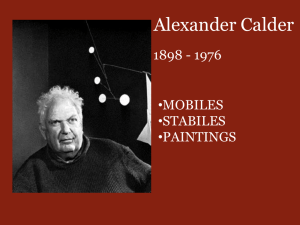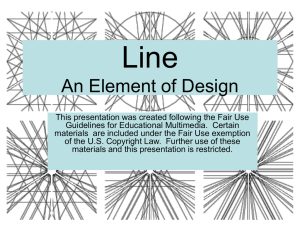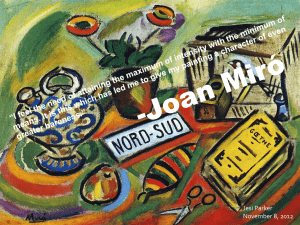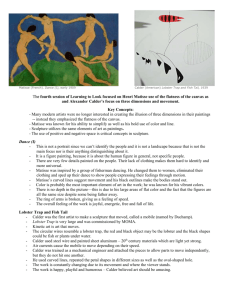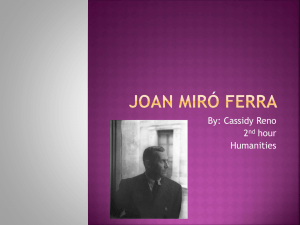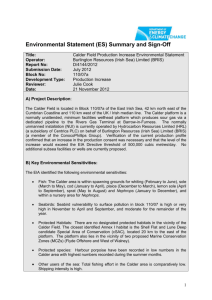Beyeler Calder Miró Media Release long
advertisement
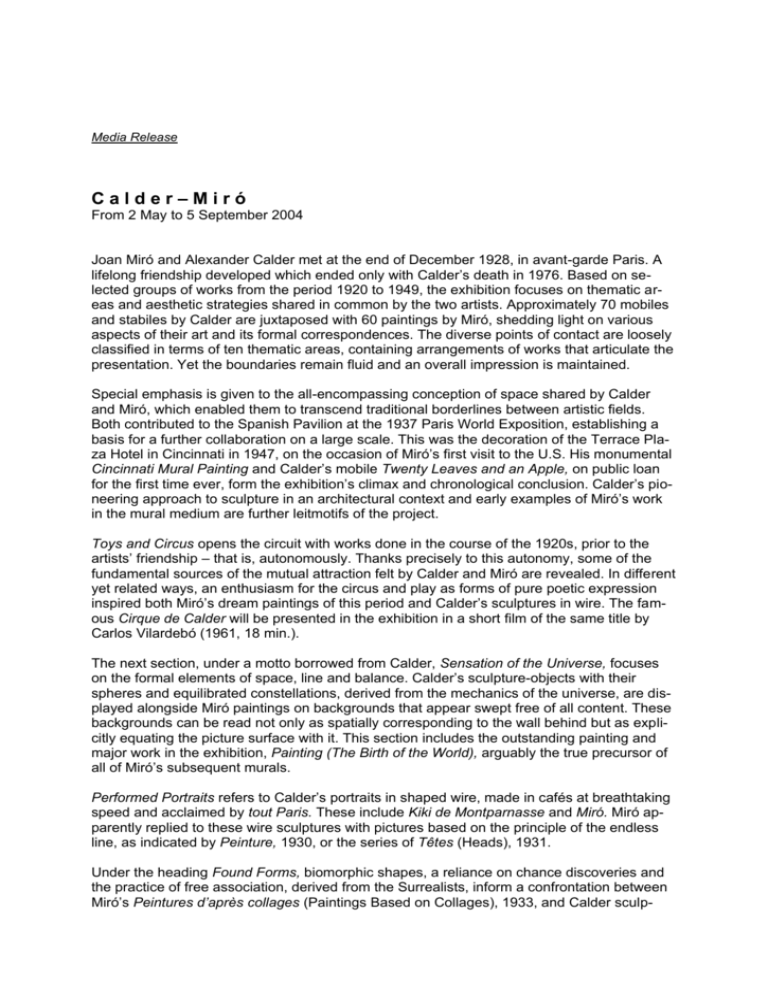
Media Release Calder–Miró From 2 May to 5 September 2004 Joan Miró and Alexander Calder met at the end of December 1928, in avant-garde Paris. A lifelong friendship developed which ended only with Calder’s death in 1976. Based on selected groups of works from the period 1920 to 1949, the exhibition focuses on thematic areas and aesthetic strategies shared in common by the two artists. Approximately 70 mobiles and stabiles by Calder are juxtaposed with 60 paintings by Miró, shedding light on various aspects of their art and its formal correspondences. The diverse points of contact are loosely classified in terms of ten thematic areas, containing arrangements of works that articulate the presentation. Yet the boundaries remain fluid and an overall impression is maintained. Special emphasis is given to the all-encompassing conception of space shared by Calder and Miró, which enabled them to transcend traditional borderlines between artistic fields. Both contributed to the Spanish Pavilion at the 1937 Paris World Exposition, establishing a basis for a further collaboration on a large scale. This was the decoration of the Terrace Plaza Hotel in Cincinnati in 1947, on the occasion of Miró’s first visit to the U.S. His monumental Cincinnati Mural Painting and Calder’s mobile Twenty Leaves and an Apple, on public loan for the first time ever, form the exhibition’s climax and chronological conclusion. Calder’s pioneering approach to sculpture in an architectural context and early examples of Miró’s work in the mural medium are further leitmotifs of the project. Toys and Circus opens the circuit with works done in the course of the 1920s, prior to the artists’ friendship – that is, autonomously. Thanks precisely to this autonomy, some of the fundamental sources of the mutual attraction felt by Calder and Miró are revealed. In different yet related ways, an enthusiasm for the circus and play as forms of pure poetic expression inspired both Miró’s dream paintings of this period and Calder’s sculptures in wire. The famous Cirque de Calder will be presented in the exhibition in a short film of the same title by Carlos Vilardebó (1961, 18 min.). The next section, under a motto borrowed from Calder, Sensation of the Universe, focuses on the formal elements of space, line and balance. Calder’s sculpture-objects with their spheres and equilibrated constellations, derived from the mechanics of the universe, are displayed alongside Miró paintings on backgrounds that appear swept free of all content. These backgrounds can be read not only as spatially corresponding to the wall behind but as explicitly equating the picture surface with it. This section includes the outstanding painting and major work in the exhibition, Painting (The Birth of the World), arguably the true precursor of all of Miró’s subsequent murals. Performed Portraits refers to Calder’s portraits in shaped wire, made in cafés at breathtaking speed and acclaimed by tout Paris. These include Kiki de Montparnasse and Miró. Miró apparently replied to these wire sculptures with pictures based on the principle of the endless line, as indicated by Peinture, 1930, or the series of Têtes (Heads), 1931. Under the heading Found Forms, biomorphic shapes, a reliance on chance discoveries and the practice of free association, derived from the Surrealists, inform a confrontation between Miró’s Peintures d’après collages (Paintings Based on Collages), 1933, and Calder sculp- tures that increasingly left rigid geometry behind, such as Tightrope or Cône d’ébène. Four of the finest examples of these Peintures stand for the eighteen-painting series and convey an overwhelming impression of the effect they unfold in space. In this regard, they can be considered immediate forerunners of the three-part wall frieze Mural I-III, executed by Miró in 1933 for the nursery in the home of his Paris dealer, Pierre Loeb. This first mural cycle in Miró’s oeuvre was finally relocated after forty years, and made available for public exhibition for the first time. Under the title Dans l’esprit desIn the spirit of Jeux d’enfants, the followingthis section recalls the playful, liberated spirit of Miró’s ballet production Jeux d’enfants (Children’s Play) for the Ballets Russes of Monte Carlo, and draws a comparison with Calder’s earliest room-sized stabiles, Big Bird and Devil Fish, which reflect the increasing entry of elements derived from nature into his abstract geometric idiom. Calder had left Paris in 1933 and bought an old farmhouse in Roxbury, Connecticut, which provided ample space to experiment with sculpture on a large scale. He would not see Miró personally again until 1937, in connection with the Paris World Exposition, where they were unexpectedly asked to collaborate on the Spanish Pavilion sponsored by the anti-Franco republic. Apart from Picasso’s epoch-making painting Guernica, the pavilion contained Calder’s ingenious Mercury Fountain and Miró’s striking mural, Le Paysan Catalan en révolte (The Catalan Peasant in Revolt; since lost). In the section Bestiary and Nursery Mural, a further Miró mural, for the children’s room of his New York dealer Pierre Matisse, along with Calder’s first definitely monumental stabile, Black Beast, reflect the oppressive effect of the threat and terrors of the world political situation on the artists’ work. In Frames and Shadows, where Calder used background panels or foreground frames to create stagelike situations, the formal elements and mobiles in clearly articulated colors play the role of actors in their own right. Miró’s paintings reflect an obvious reaction to his friend’s reduced imagery and its strong reliance on silhouettes for effect. With small-format paintings on burlap, Miró’s art began to show an increasing tendency to miniaturization at the end of the 1930s. This led, during his flight from war and devastation, to the intimate cosmogonies of the Constellations, 1940-41, in which Miró’s lyricism was structured in a way approaching the all-over field. We have been able to gather a sensational ten of these exquisite Constellations in Basel. The section The War Years: Seclusion and Constellations sheds light on this phase of forced reclusiveness and introversion. With Calder, the shortage of raw materials, metal and aluminum, and the isolation of the war years led to a renewed turn to a biomorphic idiom. Free-form elements carved from wood, occasionally brightly painted and attached with wire to stagelike configurations in space, characterized the new approach of the American artist’s Constellations. The immediate postwar period saw Calder produce some of his most condensed mobiles, which, painted entirely black, relied largely on the play of light and shadow engendered by movement. Their multiple elements held in balance, and a flickering effect that extends into the entire surrounding space, are likely the best evidence of the deep inner artistic relationship between Calder and Miró, apart from all speculation regarding reciprocal influence. Wide Open Space and PoetryLyrical Space combines works by the two artists in which these new potentials and spatial harmony in general came to full fruition. Outstanding examples of Miró’s large-format painting series of 1945 on a white, black or gray ground (this last series on view in its entirety) find an astonishing echo in Calder’s equilibrated compositions in space. Calder’s first mobile for a public space, anticipating the many art-in-architecture projects of the 1950s and 1960s, is on view here, as is his earliest surviving “performing mobile,” Ogun- quit (Orange Fish), created in 1946 for a theater project by Padraic Colum, which has come to Basel thanks to an extraordinary loan from the Tehran Museum of Contemporary Art. All of these works lead up to the climax of the exhibition, the final contributions of Calder and Miró to a common project: a mobile and a mural for the Terrace Plaza Hotel in Cincinnati. In a remarkable way, these works in the final section, Comme des Grandes Fresques –: A New Monumentality, embody Miró’s striving for a “public art” that brought increasing concentration on the mural medium, as well as Calder’s early insight that only in an architectural context could his mobiles and stabiles virtually define the surrounding space. The exhibition was initiated by Beth Elisabeth Hutton Turner, Senior Curator of The Phillips Collection in Washington, D.C., and curated in collaboration with Oliver Wick of the Fondation Beyeler. The families of the artists, whose friendship continues into their grandchildren’s generation, supported the project with great enthusiasm. Alexander S.C. Rower, representative of the Calder family and director of the Calder Foundation, not only facilitated our research but granted generous loans from the family collection. Joan Punyet Miró and Emilio Fernáandez Miró, representing the Successió Miró, accompanied our project with infectious encouragement and dedication. Catalogue of the special exhibition The catalogue, published in German and English by Philip Wilson Publishers, London, contains essays by Elisabeth Hutton Turner and Oliver Wick, a detailed chronology written from the point of view of the artists’ friendship by Susan Behrends Frank, and previously unpublished, illustrated correspondence between Calder and Miró. 312 pages with XXX 135 color plates and over XX 150 color and black and white illustrations in the text (CHF XX58.00). On opening day and each weekend thereafter, David Dimitri will convey an idea of Calder and Miró’s love of the circus in a tightrope performance in Berower Park. For details, please consult the daily press or www.beyeler.com and www.daviddimitri.ch. Contact/press: Catherine Schott, tel. + 41 (0)61 645 97 21, fax + 41 (0)61 645 97 39; presse@beyeler.com www.beyeler.com (press dossier) – press images for downloading at www.beyeler.com/press-images Opening hours of the special exhibition: 10 a.m. – 6.00 p.m. daily, Wednesdays until 8.00 p.m.

